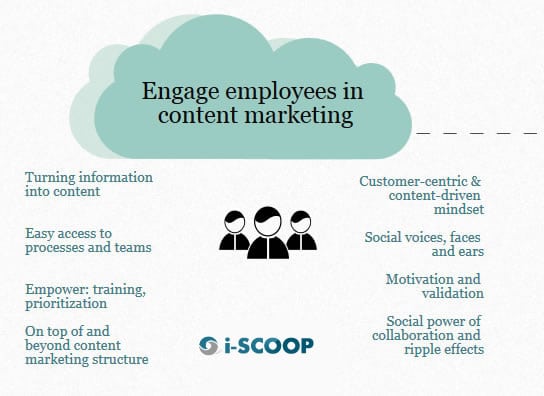 In organizations that rely heavily on content and information to attract, persuade and serve customers, the team that takes care of customer-centric content consists of more people than those who are typically and strictly involved in content marketing.
In organizations that rely heavily on content and information to attract, persuade and serve customers, the team that takes care of customer-centric content consists of more people than those who are typically and strictly involved in content marketing.
Your employees, especially those that are deeply involved in specific topics or areas that are interesting for – prospective – customers and/or business goals, as well as employees having customer-facing roles (in the broadest sense) and/or sitting on information that’s crucial to respond to customer needs, are internal goldmines that are often overlooked.
Considerations to engage employees in content marketing and social media
Whether it concerns sales consultants, product marketers, R&D managers, customer service agents, sales teams or LOB managers (list goes on), they all create content and information the whole time.
Furthermore, if they are good they understand the customer rationale behind the product/services roadmap and are attentive to customer needs and signals. And in this day and age they also bookmark, curate and often share content, information and data that could be turned in relevant content for customers. So, even when they never blog or “create” content it’s essential to get them involved as they know your target audiences and story, and have good information sitting somewhere. If they don’t, you might want to look at how customer-centric your organizational culture truly is.
Furthermore, there are ample opportunities to capture the information that is exchanged by your employees in meetings where brand, solutions, customers and business goals meet. Having a customer-centric content (marketing) plan is the essence of the use of content in a business and customer strategy context that ranks first on any priority list: make sure you have the content customers, in the broadest sense, need across their searches, buyer’s journey, etc. Getting it is not a task of nor owned by one department. You might be surprised where the best information that can be turned in relevant content sites (e.g. product team training sales in meetings….).
Here are some ways you can involve your workforce in your customer-centric content plans:
- Explain them how their information can be turned into relevant content for specific audiences and why it matters (even if it will be turned into relevant content by someone else). You need buy-in.
- Train them on the essentials of content marketing, social media and integrated/connected marketing (the benefits for them, the business and the customers but most of all how to have a content-minded, customer-centric and collaborative mindset to offer people-centric or, as I like to call it, Copernican content).
- Provide them a place and space where they can share the content they have/create and make the processes/teams you use in your company regarding content marketing easy to find/use. They must immediately know what to share with whom internally (and externally).
- It’s not a must to make everyone fully social-savvy or turn them into content marketing experts, although it wouldn’t hurt. In the end, they all have their jobs. But if that job can be done better by teaching them how to network, provide value, contribute, become a ‘social’ voice of the company and/or provide content, it’s most certainly worth the while. In the end, not knowing digital is ignoring the customer reality.
- Don’t forget this is also a matter of training, explaining, empowering, validating and doing the math regarding the objectives they can achieve using their content better and in a more public way for specific target audiences on one hand and their work objectives on the other.
- Be there where it matters. No further elaboration needed.
The goal of content marketing is not to produce as much content as you possibly can. It’s achieving business and marketing goals using content.

Even if you have a structure in place with a clear strategic view, a content plan, objectives, editorial processes and calendars, content that answers all potential questions of – prospective customers – and much more, leave the door open to all employees that create content and engage with different audiences, even if only offline, the whole time. This is not a replacement of the content audit but an important add-on.
Train, collaborate and empower to be more relevant in more ways
There is not a single organization in the world (of some size) where ALL the content, ideas, notes, thoughts, pictures, etc. that can be of value for specific audiences of ALL the consultants, subject matter experts, managers, etc. are used.
Provide employees with a purpose, a fast and easy way to provide what they have to the appropriate team members and a learning program if they want to contribute in a more intensive way, even if it’s just about using slideshare, making good presentations, interacting in LinkedIn Groups, sharing content from your blog on Twitter or identifying questions their audiences have and how to respond to them. It shouldn’t be an additional task, it should be an integral part of their job in a digital/connected business reality where the tools, technologies and platforms customers use touch virtually all business aspects and also can overlap with the internally use of such technologies.
Again, this is not about quantity and even not (just) about reach. It’s about the combined power of the human voices and faces making your business what it is. It’s about being found through the people that matter. It’s about the social ripple effect. And it’s about offering the answers to questions people have, whether it’s within the nice corporate structures, social presences and content processes, or not. Or in other words: it’s about streamlining and optimizing content and digital initiatives by prioritizing the business goals and customer objectives in a collaborative way. Just provide the essentials that give your people the confidence to do it, in accordance with some general policies.
No one knows the stories and the values of your organization better than your employees. They often just don’t know it or are not involved. And many of them also know the stories of your customers or target audiences. In practice, many will have to “unlearn” the corporate babble and sales pitches. But your workforce and collective organizational voices, faces and ears matter. And if that means prospective customer questions are answered in several ways and by several people, outside of your content marketing strategy and mix, so be it. As long as it’s relevant and providing solutions and answers always is.

